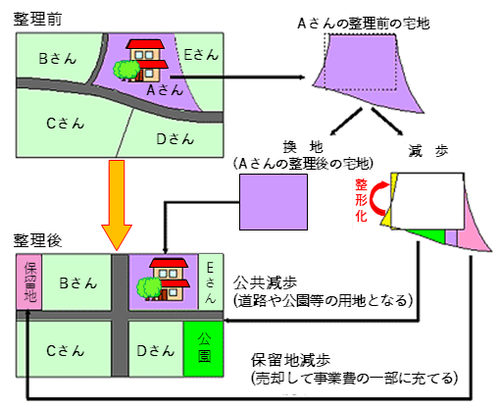Here's the text.
Mechanism of Replacement
Last Updated June 1, 2023
Replacement of land
In the land readjustment project, public facilities such as roads, parks, rivers, etc. will be maintained and improved, land parcels will be improved, and the use of residential land will be improved, taking into account the conditions of the previous residential land. Relocate residential land. Residential land that has been newly replaced by this relocation is called "replacement".
According to Article 89 of the Act, when deciding on a replacement lot, the location, land area, soil quality, water use, usage status, environment, etc. of the replacement lot and the previous residential land will be responded in accordance with the "Principle of Resonance". It must be determined to be determined.
However, since it is difficult to determine a replacement lot that will all correspond to, in fact, it is decided to determine the replacement lot so that these factors can be comprehensively considered and responded.
The important thing is to maintain fairness between neighboring lands, and it is necessary to determine replacement lots with care so that there is no unfairness or special handling of certain residential lands.
Temporary replacement land
In the land readjustment project, if there are buildings on land that will become roads in the future or land that requires residential land maintenance, road construction work and residential land maintenance work cannot be performed only after the buildings have been relocated. Therefore, the enforcer of the land readjustment project designates a "temporary resettlement" and starts construction of public facilities after the right holder moves from the previous residential land to the temporary resettlement.
In general, temporary land lots are designated as residential land that will be replaced in the future.
Reduced walking
In the land readjustment project, land required for public facilities such as roads, parks, rivers, and reserved land is gradually provided by the right holders in the district as "reduction of walking" according to their rights. It is a mechanism to have you provide.
The decrease in the area of residential land by business is called "reduction of walking".

Land evaluation
Land evaluation in the land readjustment project is different from land evaluation for buying and selling, and aims to evaluate the increase (degree of increase) of land value by the project. . For this reason, in the evaluation, "land evaluation standards" are determined based on different characteristics and situations for each district, and the evaluation is made fairly.
Method of evaluation
There are several types of evaluation methods, but in general, land evaluation is performed using the "land price evaluation method". This method is based on the land price attached to the road facing the residential land, taking into account the individual elements of each residential land.
In the land readjustment project, the land evaluation in the land readjustment project evaluates the residential land before and after the reorganization at the same time, so that the land evaluation is performed without being affected by the rise or fall in land prices during a long period of time. It is possible.
Clearing money
As a general rule, land lots are determined for all residential lands in the district, but due to the placement of public facilities such as roads, parks, rivers, etc., it is difficult to allocate all land lots without excess or deficiency, There is a certain degree of imbalance on each land lot.
Clearing money is money exchanged between right holders through the enforcer in order to correct this imbalance.
Inquiries to this page
Urban Development Coordination Division, Urban Development Bureau Urban Development Department
Telephone: 045-671-2695
Telephone: 045-671-2695
Fax: 045-664-7694
Email address: tb-seibichosei@city.yokohama.lg.jp
Page ID: 377-652-671







